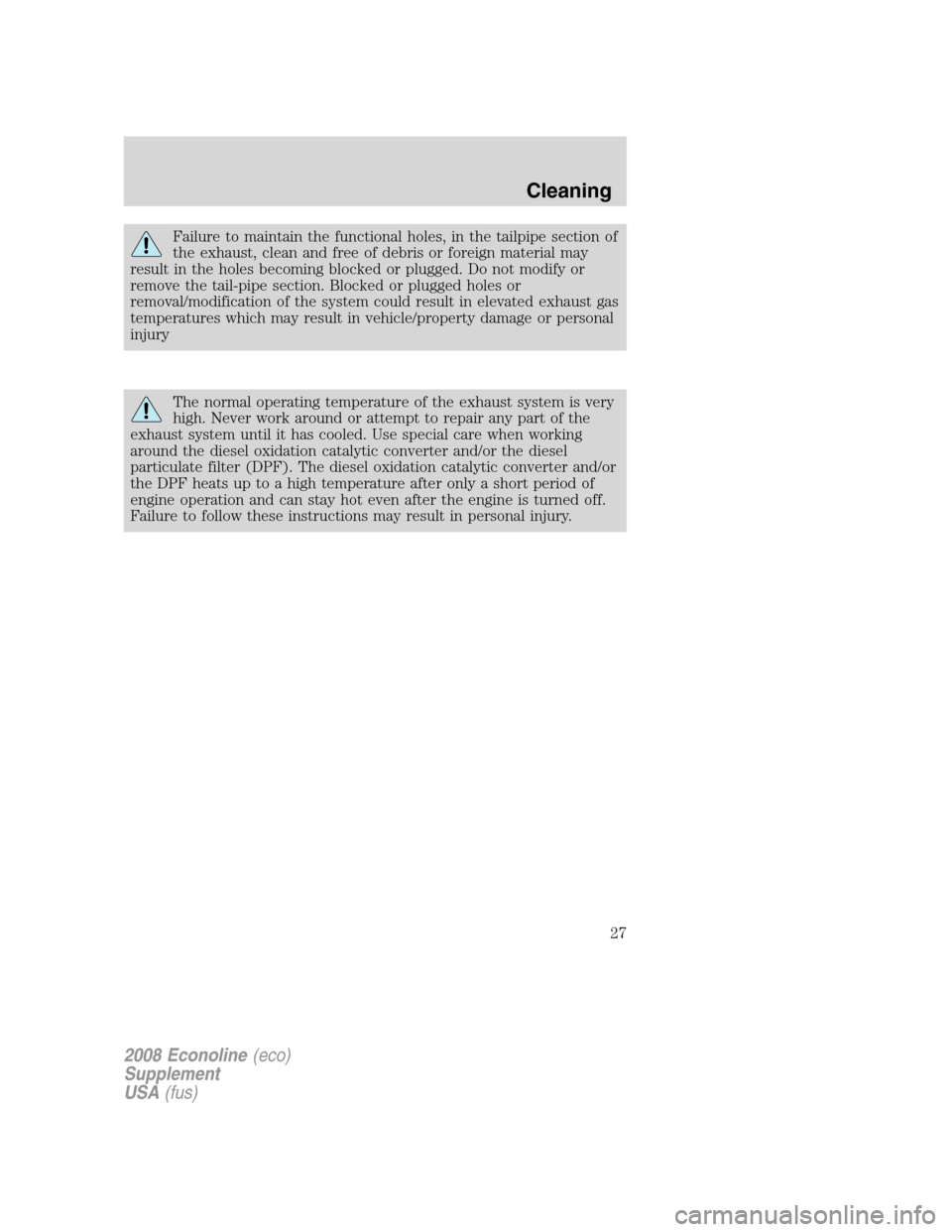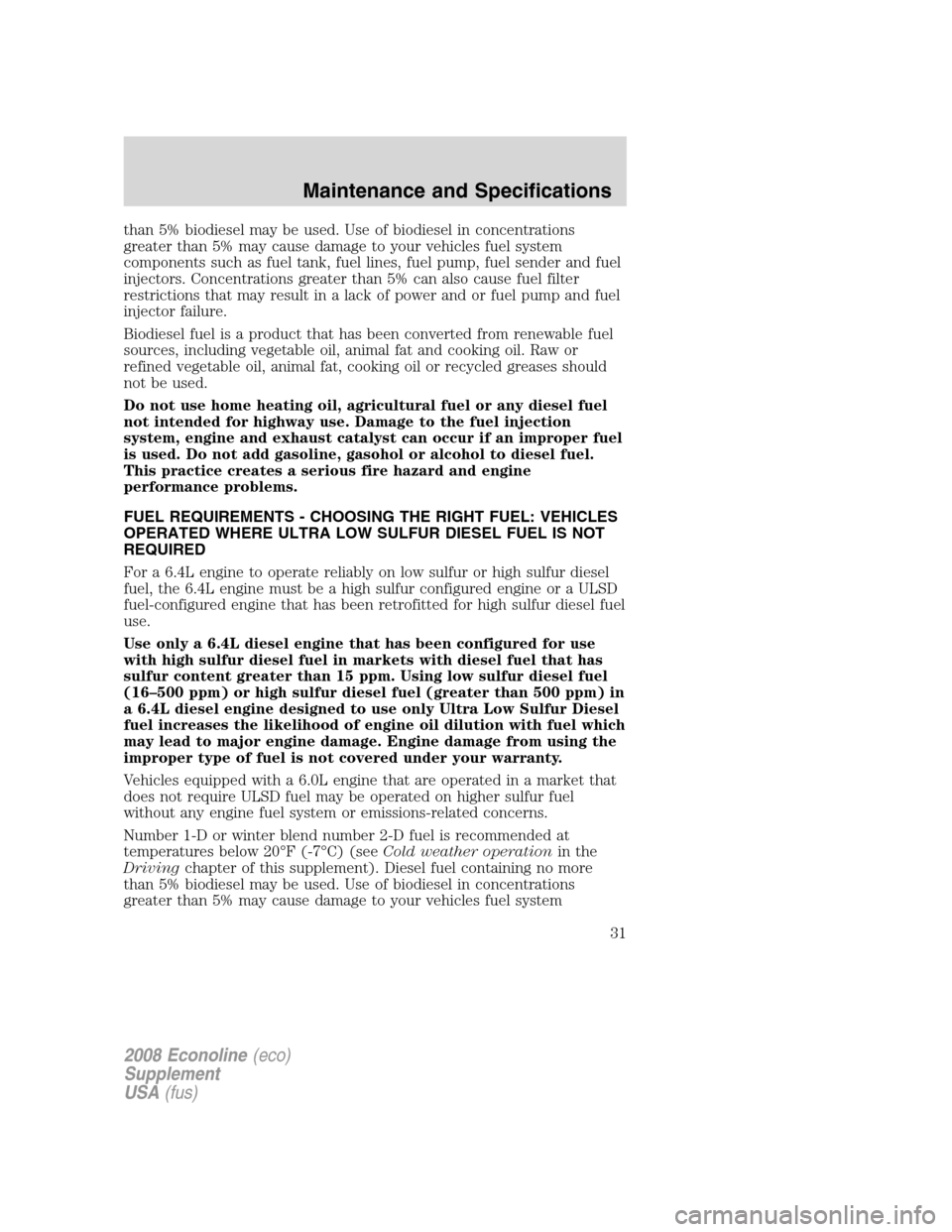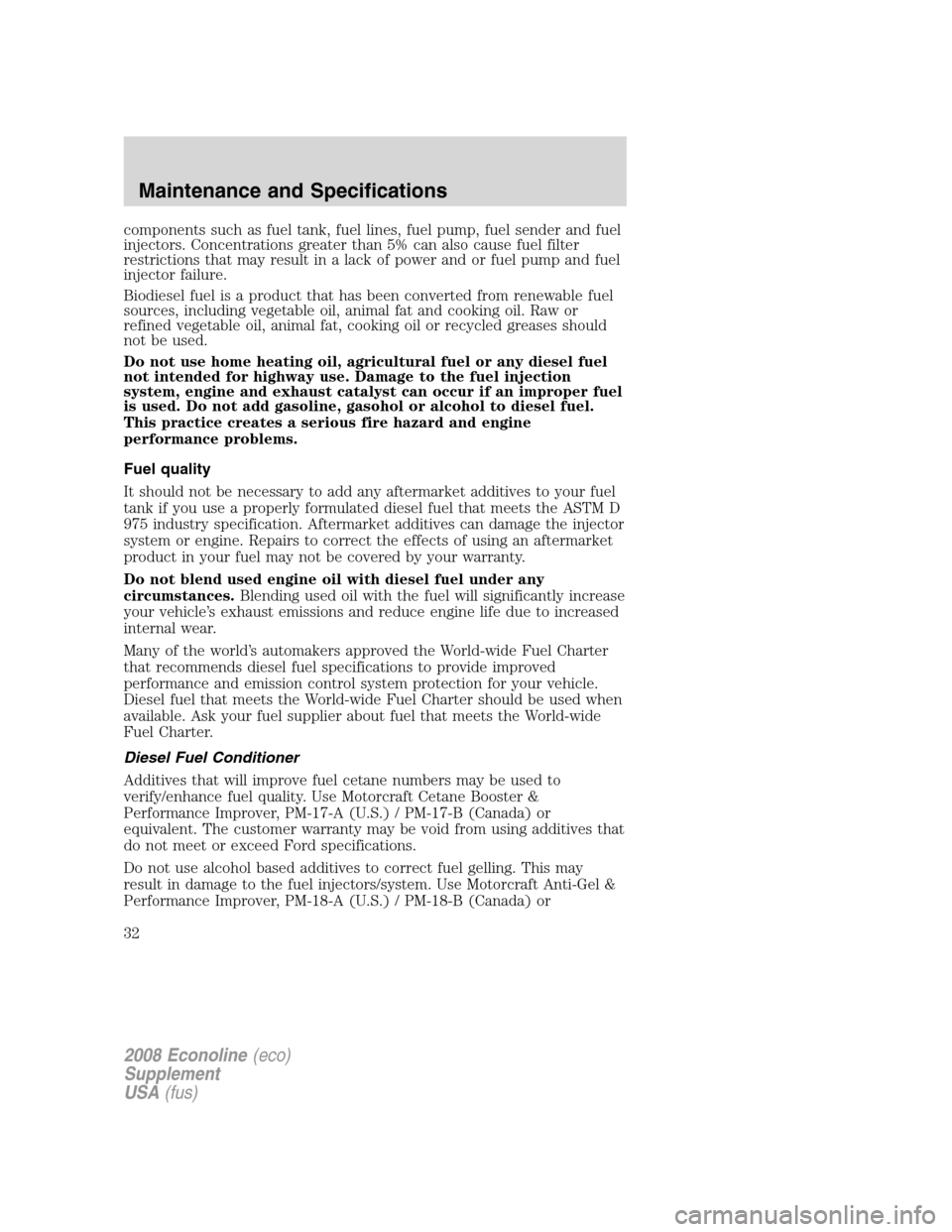Page 25 of 96
ENGINE
Engines are more efficient when they are clean because grease and dirt
buildup keep the engine warmer than normal. When washing:
•Take care when using a power washer to clean the engine. The
high-pressure fluid could penetrate the sealed parts and cause
damage.
•Do not spray a hot engine with cold water to avoid cracking the
engine block or other engine components.
•Spray Motorcraft Engine Shampoo and Degreaser (ZC-20) on all parts
that require cleaning and pressure rinse clean.
•Never wash or rinse the engine while it is running; water in the
running engine may cause internal damage.
•Cover the highlighted areas to prevent water damage when cleaning
the engine.
•E–Series
2008 Econoline(eco)
Supplement
USA(fus)
Cleaning
25
Page 26 of 96
•F–Super Duty
EXHAUST (F-SUPER DUTY ONLY)
The visible holes in each leg of the twin tip and the holes under the
shield just inboard of the right rear tire(s) are functional. The holes need
to be kept clear of mud/debris or foreign material to maintain proper
function of the exhaust system. Clean and remove debris or foreign
material if present as needed. Spraying with a hose during regular
washing of vehicle should help keep holes clean/clear of debris or foreign
material.
2008 Econoline(eco)
Supplement
USA(fus)
Cleaning
26
Page 27 of 96

Failure to maintain the functional holes, in the tailpipe section of
the exhaust, clean and free of debris or foreign material may
result in the holes becoming blocked or plugged. Do not modify or
remove the tail-pipe section. Blocked or plugged holes or
removal/modification of the system could result in elevated exhaust gas
temperatures which may result in vehicle/property damage or personal
injury
The normal operating temperature of the exhaust system is very
high. Never work around or attempt to repair any part of the
exhaust system until it has cooled. Use special care when working
around the diesel oxidation catalytic converter and/or the diesel
particulate filter (DPF). The diesel oxidation catalytic converter and/or
the DPF heats up to a high temperature after only a short period of
engine operation and can stay hot even after the engine is turned off.
Failure to follow these instructions may result in personal injury.
2008 Econoline(eco)
Supplement
USA(fus)
Cleaning
27
Page 28 of 96
IDENTIFYING COMPONENTS IN THE ENGINE COMPARTMENT
E-Series
1. Windshield washer fluid reservoir
2. Automatic transmission dipstick
3. Engine oil filler cap
4. Secondary fuel filter assembly (out of view)
5. Power steering fluid reservoir
6. Brake fluid reservoir
7. Engine coolant reservoir
8. Air filter assembly
9. Engine oil dipstick
10. Power distribution box
The Fuel Conditioner Module (FCM) is located on the driver-side of the
vehicle next to the transmission case.
2008 Econoline(eco)
Supplement
USA(fus)
Maintenance and Specifications
28
Page 29 of 96
F-Super Duty
1. Windshield washer fluid reservoir
2. Batteries
3. Air filter assembly and restriction gauge
4. Automatic transmission dipstick (if equipped)
5. Engine oil fill
6. Engine oil filter
7. Engine-mounted fuel filter assembly
8. Engine oil dipstick
9. Fuel coolant reservoir
10. Brake fluid reservoir
11. Power distribution box (behind engine coolant reservoir)
12. Engine coolant reservoir
13. Power steering fluid reservoir
2008 Econoline(eco)
Supplement
USA(fus)
Maintenance and Specifications
29
Page 30 of 96

The Horizontal Fuel Conditioner Module (HFCM) is located on the
frame-rail under the driver-side floorboard near the transmission.
SCHEDULED MAINTENANCE
The scheduled maintenance services in thescheduled maintenance
informationof this supplement are required because they are
considered essential to the life and performance of your vehicle.
Use only recommended fuel, lubricants, fluids and service parts
conforming to Ford specifications. Motorcraft parts are designed and
built for best performance in your vehicle.
FUEL REQUIREMENTS - CHOOSING THE RIGHT FUEL: VEHICLES
OPERATED WHERE ULTRA LOW SULFUR DIESEL FUEL IS
REQUIRED (UNITED STATES/CANADA/PUERTO RICO/U.S. VIRGIN
ISLANDS AND OTHER LOCALES)
Use only Ultra Low Sulfur (15 ppm Sulfur Maximum) number 1-D
or 2-D diesel fuel in your 6.0L or 6.4L diesel engine.The engine
and exhaust system were designed to only use this fuel. Look for the
ULTRA-LOW SULFUR HIGHWAY DIESEL FUEL (15 ppm Sulfur
Maximum)label on fuel pumps when purchasing your fuel.
Using low sulfur diesel fuel (16-500 ppm) or high sulfur diesel
fuel (greater than 500 ppm) in a 6.4L diesel engine designed to
use only Ultra Low Sulfur Diesel fuel will cause certain emission
components to malfunction which may also cause the Check
Engine(
)light to illuminate indicating an emissions-related
concern.
Number 1-D or winter blend number 2-D fuel is recommended at
temperatures below 20°F (-7°C) (seeCold weather operationin the
Drivingchapter of this supplement). Diesel fuel containing no more
2008 Econoline(eco)
Supplement
USA(fus)
Maintenance and Specifications
30
Page 31 of 96

than 5% biodiesel may be used. Use of biodiesel in concentrations
greater than 5% may cause damage to your vehicles fuel system
components such as fuel tank, fuel lines, fuel pump, fuel sender and fuel
injectors. Concentrations greater than 5% can also cause fuel filter
restrictions that may result in a lack of power and or fuel pump and fuel
injector failure.
Biodiesel fuel is a product that has been converted from renewable fuel
sources, including vegetable oil, animal fat and cooking oil. Raw or
refined vegetable oil, animal fat, cooking oil or recycled greases should
not be used.
Do not use home heating oil, agricultural fuel or any diesel fuel
not intended for highway use. Damage to the fuel injection
system, engine and exhaust catalyst can occur if an improper fuel
is used. Do not add gasoline, gasohol or alcohol to diesel fuel.
This practice creates a serious fire hazard and engine
performance problems.
FUEL REQUIREMENTS - CHOOSING THE RIGHT FUEL: VEHICLES
OPERATED WHERE ULTRA LOW SULFUR DIESEL FUEL IS NOT
REQUIRED
For a 6.4L engine to operate reliably on low sulfur or high sulfur diesel
fuel, the 6.4L engine must be a high sulfur configured engine or a ULSD
fuel-configured engine that has been retrofitted for high sulfur diesel fuel
use.
Use only a 6.4L diesel engine that has been configured for use
with high sulfur diesel fuel in markets with diesel fuel that has
sulfur content greater than 15 ppm. Using low sulfur diesel fuel
(16–500 ppm) or high sulfur diesel fuel (greater than 500 ppm) in
a 6.4L diesel engine designed to use only Ultra Low Sulfur Diesel
fuel increases the likelihood of engine oil dilution with fuel which
may lead to major engine damage. Engine damage from using the
improper type of fuel is not covered under your warranty.
Vehicles equipped with a 6.0L engine that are operated in a market that
does not require ULSD fuel may be operated on higher sulfur fuel
without any engine fuel system or emissions-related concerns.
Number 1-D or winter blend number 2-D fuel is recommended at
temperatures below 20°F (-7°C) (seeCold weather operationin the
Drivingchapter of this supplement). Diesel fuel containing no more
than 5% biodiesel may be used. Use of biodiesel in concentrations
greater than 5% may cause damage to your vehicles fuel system
2008 Econoline(eco)
Supplement
USA(fus)
Maintenance and Specifications
31
Page 32 of 96

components such as fuel tank, fuel lines, fuel pump, fuel sender and fuel
injectors. Concentrations greater than 5% can also cause fuel filter
restrictions that may result in a lack of power and or fuel pump and fuel
injector failure.
Biodiesel fuel is a product that has been converted from renewable fuel
sources, including vegetable oil, animal fat and cooking oil. Raw or
refined vegetable oil, animal fat, cooking oil or recycled greases should
not be used.
Do not use home heating oil, agricultural fuel or any diesel fuel
not intended for highway use. Damage to the fuel injection
system, engine and exhaust catalyst can occur if an improper fuel
is used. Do not add gasoline, gasohol or alcohol to diesel fuel.
This practice creates a serious fire hazard and engine
performance problems.
Fuel quality
It should not be necessary to add any aftermarket additives to your fuel
tank if you use a properly formulated diesel fuel that meets the ASTM D
975 industry specification. Aftermarket additives can damage the injector
system or engine. Repairs to correct the effects of using an aftermarket
product in your fuel may not be covered by your warranty.
Do not blend used engine oil with diesel fuel under any
circumstances.Blending used oil with the fuel will significantly increase
your vehicle’s exhaust emissions and reduce engine life due to increased
internal wear.
Many of the world’s automakers approved the World-wide Fuel Charter
that recommends diesel fuel specifications to provide improved
performance and emission control system protection for your vehicle.
Diesel fuel that meets the World-wide Fuel Charter should be used when
available. Ask your fuel supplier about fuel that meets the World-wide
Fuel Charter.
Diesel Fuel Conditioner
Additives that will improve fuel cetane numbers may be used to
verify/enhance fuel quality. Use Motorcraft Cetane Booster &
Performance Improver, PM-17-A (U.S.) / PM-17-B (Canada) or
equivalent. The customer warranty may be void from using additives that
do not meet or exceed Ford specifications.
Do not use alcohol based additives to correct fuel gelling. This may
result in damage to the fuel injectors/system. Use Motorcraft Anti-Gel &
Performance Improver, PM-18-A (U.S.) / PM-18-B (Canada) or
2008 Econoline(eco)
Supplement
USA(fus)
Maintenance and Specifications
32